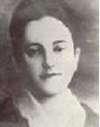Ana Betancourt
Ana Betancourt (December 14, 1832 Camagüey, Cuba – February 7, 1901 Madrid, Spain) was a Cuban woman who took a leading role in the war of independence from Spain.[1] She is a national heroine in Cuba.
Ana Betancourt | |
|---|---|
 | |
| Born | Ana Betancourt December 14, 1832 |
| Died | July 2, 1901 (aged 68) Madrid, Spain |
| Occupation | Cuban patriot |
| Known for | Patriotic support of Cuban independence from Spain and her support of women's emancipation as part of this struggle. |
Life
The first Cuban war of independence from Spain began in 1868. Women, known as Mambisas, played a significant role in the war, as political agitators, nurses, and fighters. Ana Betancourt, was from a wealthy landholding family and was one of the first to argue for women in Cuban.[2] She was married to the patriot Ignacio Mora de la Pera.[3] In 1869, she addressed the Constitutional Assembly of Cuban patriots at Guáimaro in which she linked female emancipation to the abolition of slavery and the struggle against colonialism.[4] Although unused to hardship she lived in the forest with the revolutionaries.
On July 9, 1871, she and her husband were taken by surprise by the Spanish forces and captured. She was sentenced to exile in Spain where she lived the rest of her life never seeing de la Pera again.[2] She continued to support the cause of Cuban independence from her exile.
At the age of 69 in 1901 she was about to return to her native country but contracted fulminating bronchopneumonia and died before she could begin her journey. Her remains were buried in Spain until 1968. In that year they were set in the pantheon of the Revolutionary Armed Forces, in the Cemetery Colón in Havana.
Commemorations
She is commemorated in the modern Republic of Cuba by the Order of Anna Betancourt medal, awarded to Cuban women who "demonstrate revolutionary and internationalist merit and anti-imperialist fidelity and/or great merit in a field of work that contributes to the national interest." Originally this was the highest award of the Federation of Cuban Women, and the order was officially sanctioned in 1979 as a state award.[5] Notable recipients include the Palestinian poet May Sayegh.
The Cuban Ana Betancourt schools for rural girls are named in her honor.[6]
References
- K. Lynn Stoner; Luiś Hipólito Serrano Pérez, eds. (2000). Cuban and Cuban American women : an annotated bibliography (1st ed.). Wilmington, Del.: Scholarly Resources. p. 9. ISBN 0842026436.
- Boles, Janet K.; Hoeveler, Diane Long (2004). Historical dictionary of feminism (2nd ed.). Lanham, Md.: Scarecrow Press. p. 54. ISBN 0810849461.
- Jr, Louis A. Pérez (2005). To die in Cuba : suicide and society. Chapel Hill [u.a.]: Univ. of North Carolina Press. p. 103. ISBN 0807829374.
- Stoner, K. Lynn (1991). From the house to the streets : the Cuban woman's movement for legal reform, 1898-1940. Durham: Duke University Press. pp. 22–23. ISBN 0822311496.
- Janda, Margaret Randall with photographs by Judy (1981). Women in Cuba : twenty years later. New York: Smyrna Press. p. 56. ISBN 0918266149.
- ed.; Maloof, transl. by Judy (1999). Voices of resistance : testimonies of Cuban and Chilean women. Lexington, Ky.: Univ. Press of Kentucky. p. 30. ISBN 0813120799.CS1 maint: extra text: authors list (link)
- Mariano Jimenez II and Mariano G. Jiménez (September 2005). "Ana Betancourt en Patriotas Cubanas" (in Spanish). Guije.com. Retrieved 2007-09-09.
- "Ana Betancourt Order". Orders and Medals Society of America. Archived from the original on 2011-07-19. Retrieved 2007-09-09.
- Lázaro David Najarro Pujol. "Ana Betancourt de Mora: A history, a woman, a city". Radio Cadena Agramonte. Archived from the original on 2007-06-30. Retrieved 2007-09-09.
- Stoner, K. Lynn (2000). Cuban and Cuban-American Women: An Annotated Bibliography. Rowman & Littlefield. ISBN 0-8420-2643-6.
- Smith, Lois M.; Padula, Alfred (1996). Sex and Revolution: Women in Socialist Cuba. USA: Oxford University Press. ISBN 0-19-509491-3.